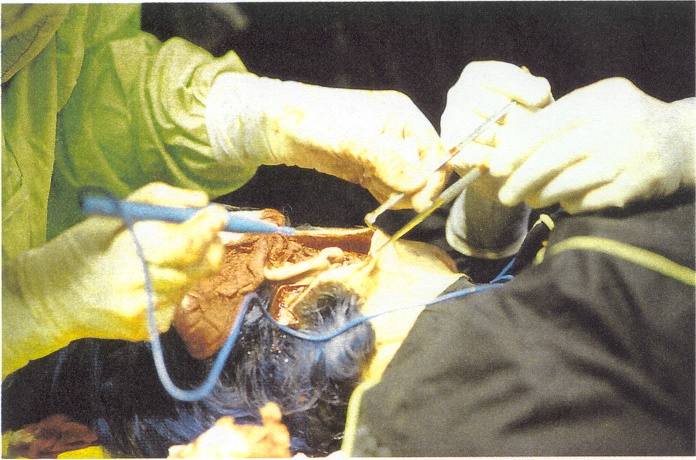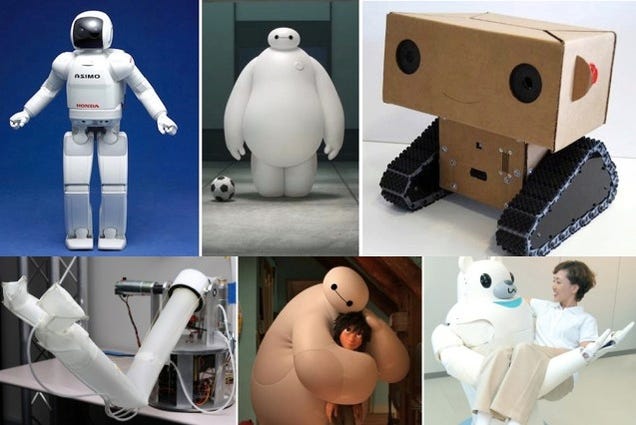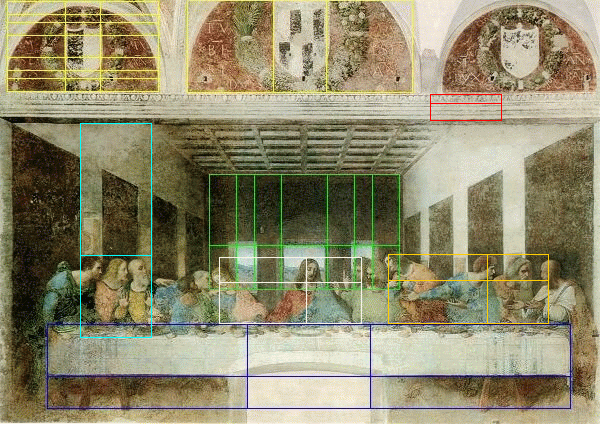When
mixed with medical technology, art seems to have a much more personal effect
with the body and self. A person looking at an abstract painting may feel some
connection to the shapes and lines being shown. However, the experience is substantially
different when the art is affecting a person physically.


The inside of a head from one of the Body World exhibits (4).
In my
own personal experience, I saw the exhibition of Body Worlds when it came to
the Bay Area several years ago. The art was surreal since the gallery was using
actual bodies through plastination. Even though it was not necessarily me
surrounded by glass and watchful eyes, it made me reflect on my own body and
what my internal self really looks like. In many ways, it was similar to
Casini’s idea of looking into a mirror. Although he was talking about MRIs, the
same concept can be applied here. In my mind, I was taking that image of the
person and seeing my own self in that body.
The process of the plastination technique used for the Body Worlds exhibit (1).
This
idea of the self in association to medical technology and art also explains why
many people hid their faces during Orlan’s live surgeries during the 1990’s. A
woman in the documentary comments on how the audience reacted with horror to
the performance even though they see and hear about so much violence on
television. The experience is different, though, because many people are
imagining themselves in Orlan’s situation and reacting to her face being sliced
open. This phenomena is typically known as pain empathy (3), and the
effects can be found in many recent movies such as 127 Hours (5). Most likely, this feeling is found in art with
medical technology due to the fact that the body is a commonly used medium in
this art form.

This is a photograph of Orlan during one of her live surgeries (3).
By
bringing this type of self-reflection into art, medical technology can also be
beneficial to a person. Diane Gromala uses virtual reality to treat pain by
having the environments react to a person’s responses, while Virgil
Wong creates apps to show one’s digital persona in the future in order to curb
bad habits. In both cases, people are changing themselves for the better
based on a visual stimulus. These technologies are again acting like mirrors
for the users with the stimuli representing the people themselves.

Virgil Wong is creating a digital persona to show a person's age based on health characteristics (2).
1. Casini, Silvia. Magnetic Resonance Imaging (MRI) as MIrror and Portrait: MRI Configurations between Science and the Arts. N.p.: Johns Hopkins UP and the Society for Literature and Science, 2011. Print.
4. Orlan - Carnal Art (2001). Dir. Stephan Oriach. Perf. Orlan. YouTube. Myriapodus Films, 13 Mar. 2011. Web. 1 July 2016. <https://www.youtube.com/watch?v=no_66MGu0Oo>.
8. Vesna, Victoria. "Medicine Part 3." YouTube. uconlineprogram, 22 Apr. 2012. Web. 1 July 2016. <https://www.youtube.com/watch?v=FIX-9mXd3Y4>.
9. Virgil. Virgil Wong, n.d. Web. 2 July 2016. < http://virgilwong.com/>.
2. Digital image. Virgil. Virgil Wong, n.d. Web. 2 July 2016. <http://virgilwong.com/research/>.
Through these observations, medical
technology appears to be bringing the art world closer to one’s own identity.
Sources:
1. Casini, Silvia. Magnetic Resonance Imaging (MRI) as MIrror and Portrait: MRI Configurations between Science and the Arts. N.p.: Johns Hopkins UP and the Society for Literature and Science, 2011. Print.
2. Gromala, Diane. "TEDxAmericanRiviera - Diane Gromala -
Curative Powers of Wet, Raw Beauty." TEDxAmericanRiviera. YouTube. TEDx
Talks, 7 Dec. 2011. Web. 1 July 2016.
3. Inglis-Arkell, Esther. "This Is How You Literally Feel Other People's Pain." io9. Gizmodo, 11 July 2014. Web. 2 July 2016. <http://io9.gizmodo.com/this-is-how-you-literally-feel-other-peoples-pain-1603076553>.
4. Orlan - Carnal Art (2001). Dir. Stephan Oriach. Perf. Orlan. YouTube. Myriapodus Films, 13 Mar. 2011. Web. 1 July 2016. <https://www.youtube.com/watch?v=no_66MGu0Oo>.
5. Rossen, Jake. "7 Movies That Sent People Running Out of
Theaters." Mental Floss. Mental Floss Inc., 2 Oct. 2015. Web. 2 July 2016.
<http://mentalfloss.com/article/69377/7-movies-sent-people-running-out-theaters>.
6. TEDxAmericanRiviera - Diane Gromala - Curative Powers of
Wet, Raw Beauty. Perf. Diane Gromala. YouTube. TEDx Talks, 7 Dec. 2011. Web. 1
July 2016. <https://www.youtube.com/watch?v=cRdarMz--Pw>.
7. Vesna, Victoria. "Medicine Part 1." YouTube. uconlineprogram,
21 Apr. 2012. Web. 1 July 2016. <https://www.youtube.com/watch?v=Ep0M2bOM9Tk>.
8. Vesna, Victoria. "Medicine Part 3." YouTube. uconlineprogram, 22 Apr. 2012. Web. 1 July 2016. <https://www.youtube.com/watch?v=FIX-9mXd3Y4>.
9. Virgil. Virgil Wong, n.d. Web. 2 July 2016. < http://virgilwong.com/>.
Images/Videos:
1. BODY WORLDS - The Plastination Technique. YouTube. Body
Worlds, 27 Aug. 2013. Web. 2 July 2016. <https://www.youtube.com/watch?v=Q_8ZEW2CGKo>.
2. Digital image. Virgil. Virgil Wong, n.d. Web. 2 July 2016. <http://virgilwong.com/research/>.
3. N.d. English 114EM: Women Writers, 1650-1760. By Denee
Pescarmona. 2003. Web. 2 July 2016.
<http://oldsite.english.ucsb.edu/faculty/ecook/courses/eng114em/surgeries.htm>.
4. N.d. Pinterest. Pinterest. Web. 2 July 2016. <https://www.pinterest.com/valeanette/gunther-von-hagensbody-worlds/>.






